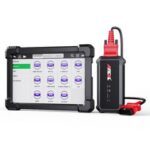Do you ever wonder what’s really going on under the hood of your car? Modern vehicles are complex machines, constantly monitored by sophisticated computer systems. An OBD2 scanner is your key to accessing this hidden information, allowing you to understand your car’s health, diagnose problems, and even improve its performance.
An OBD2 scanner, or On-Board Diagnostics II scanner, is a powerful tool that connects to your car’s computer system, typically through a port located under the dashboard. This connection allows you to read a wealth of data, from engine performance metrics to diagnostic trouble codes (DTCs) that signal potential issues. Think of it as a translator, turning your car’s complex signals into understandable information that you can use.
One of the primary functions of an OBD2 scanner is to read and interpret DTC fault codes. When your car’s computer detects a problem, it generates a code and often illuminates the “check engine light.” While this light can be alarming, an OBD2 scanner can quickly tell you exactly what the code means. Instead of guessing or immediately taking your car to a mechanic, you can use a scanner to identify the problem yourself. Many scanners also provide descriptions of these codes, giving you a clearer understanding of the issue, whether it’s a minor sensor malfunction or a more significant engine problem. This knowledge empowers you to make informed decisions about repairs, potentially saving you time and money.
Beyond just reading fault codes, a quality OBD2 scanner offers a wide range of features. Real-time monitoring of your car’s sensors is invaluable for understanding its performance. You can track parameters like engine temperature, RPM, speed, fuel consumption, and much more, all displayed on your smartphone or tablet via a compatible app. This live data stream can help you identify anomalies, optimize your driving habits for fuel efficiency, or even diagnose performance issues as they occur.
Advanced OBD2 scanners and apps, like Car Scanner, go even further. They allow you to access extended PIDs (Parameter IDs), which are manufacturer-specific data points not available through standard OBD2 protocols. This unlocks even deeper insights into your car’s operation, providing information that was previously only accessible to dealership technicians. Furthermore, features like Mode 06 testing allow you to view the results of your car’s self-monitoring tests, giving you proactive insights into potential problems before they even trigger a fault code.
For car enthusiasts and DIY mechanics, the customization options offered by some OBD2 scanner apps are a major draw. Imagine creating your own personalized dashboard displaying only the gauges and charts that are most important to you. With Car Scanner, you can do just that, tailoring the interface to your specific needs and interests. You can monitor acceleration performance with built-in tools, track trip statistics, and even use a HUD (Heads-Up Display) mode to project data onto your windshield for safer, more convenient viewing.
Choosing the right OBD2 scanner involves considering compatibility and features. The OBD2 standard is universal for most vehicles built after 1996, but it’s always wise to confirm compatibility with your specific car model. You’ll also need to select an OBD2 adapter, typically Bluetooth or Wi-Fi enabled, to connect your car to your smartphone or tablet. Reputable adapter brands like Kiwi 3, Viecar, and Veepeak are known for their reliability. Be cautious of very cheap, unbranded adapters, as some may be unreliable or even cause connection issues.
In conclusion, an OBD2 scanner is an indispensable tool for modern car owners. Whether you’re a seasoned mechanic or simply want to understand your car better, an OBD2 scanner empowers you with valuable diagnostic information and real-time performance data. By choosing a quality scanner and utilizing a feature-rich app like Car Scanner, you can unlock your car’s secrets, save money on unnecessary repairs, and enjoy a more informed and confident driving experience.
